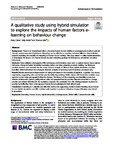A qualitative study using hybrid simulation to explore the impacts of human factors e-learning on behaviour change
| dc.contributor.author | Carter, H | |
| dc.contributor.author | Hanks, Sally | |
| dc.contributor.author | Gale, Thomas | |
| dc.date.accessioned | 2020-09-17T09:32:13Z | |
| dc.date.issued | 2020-08-12 | |
| dc.identifier.issn | 2059-0628 | |
| dc.identifier.issn | 2059-0628 | |
| dc.identifier.other | 20 | |
| dc.identifier.uri | http://hdl.handle.net/10026.1/16376 | |
| dc.description.abstract |
<jats:title>Abstract</jats:title><jats:sec> <jats:title>Background</jats:title> <jats:p>There is an international drive to increase human factors training in undergraduate medical curricula through various educational platforms. E-learning can be effective at teaching technical skills but there is limited research exploring the benefits of e-learning in human factors training. This study aimed to utilise hybrid simulation to investigate the impact of a human factors focused e-learning package for intravenous cannulation on safety behaviours.</jats:p> </jats:sec><jats:sec> <jats:title>Methods</jats:title> <jats:p>Video-reflexive ethnography (VRE) techniques and interviews were used to explore human factor-related behaviour change in hybrid simulation scenarios, before and after e-learning modular training. Ten final-year medical students were recruited for the study. Content analysis of VRE data from hybrid simulation scenarios identified which behaviours had changed; thematic analysis of semi-structured interviews uncovered why.</jats:p> </jats:sec><jats:sec> <jats:title>Results</jats:title> <jats:p>Results demonstrate improvement in safety behaviours in the domains of physical-, cognitive- and macro-ergonomics, suggesting safer cannulation practice following training. Online videos with interactive activities were reported as the major pedagogical driver for change. The impact of the e-learning was identified across four themes: environment, person, policy-related tasks, and preparedness for practise. Reported intention to change practise and altered behaviour in the workplace supports the conclusion that this training prepares students for practise by facilitating them to incorporate human factors principles in their clinical work.</jats:p> </jats:sec><jats:sec> <jats:title>Conclusion</jats:title> <jats:p>E-learning is a valuable and effective method for supporting medical student learning about human factors. Hybrid simulation and VRE combine well together to evaluate behaviour change following educational interventions.</jats:p> </jats:sec> | |
| dc.format.extent | 20- | |
| dc.format.medium | Electronic-eCollection | |
| dc.language | en | |
| dc.language.iso | en | |
| dc.publisher | BMC | |
| dc.subject | Clinical skills | |
| dc.subject | Communication skills | |
| dc.subject | E-learning | |
| dc.subject | Human factors | |
| dc.subject | Hybrid simulation | |
| dc.subject | Undergraduate | |
| dc.title | A qualitative study using hybrid simulation to explore the impacts of human factors e-learning on behaviour change | |
| dc.type | journal-article | |
| dc.type | Journal Article | |
| plymouth.author-url | https://www.ncbi.nlm.nih.gov/pubmed/32817807 | |
| plymouth.issue | 1 | |
| plymouth.volume | 5 | |
| plymouth.publication-status | Published | |
| plymouth.journal | Advances in Simulation | |
| dc.identifier.doi | 10.1186/s41077-020-00136-y | |
| plymouth.organisational-group | /Plymouth | |
| plymouth.organisational-group | /Plymouth/Faculty of Health | |
| plymouth.organisational-group | /Plymouth/Faculty of Health/Peninsula Dental School | |
| plymouth.organisational-group | /Plymouth/Faculty of Health/Peninsula Medical School | |
| plymouth.organisational-group | /Plymouth/REF 2021 Researchers by UoA | |
| plymouth.organisational-group | /Plymouth/REF 2021 Researchers by UoA/UoA23 Education | |
| plymouth.organisational-group | /Plymouth/Users by role | |
| plymouth.organisational-group | /Plymouth/Users by role/Academics | |
| dc.publisher.place | England | |
| dcterms.dateAccepted | 2020-07-21 | |
| dc.rights.embargodate | 2020-9-19 | |
| dc.identifier.eissn | 2059-0628 | |
| dc.rights.embargoperiod | Not known | |
| rioxxterms.versionofrecord | 10.1186/s41077-020-00136-y | |
| rioxxterms.licenseref.uri | http://www.rioxx.net/licenses/all-rights-reserved | |
| rioxxterms.licenseref.startdate | 2020-08-12 | |
| rioxxterms.type | Journal Article/Review |


